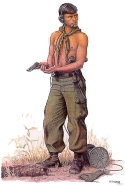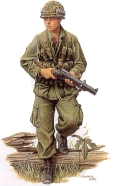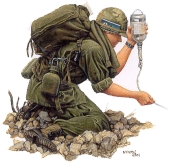Ninth Marines in Vietnam
 On March 8th, 1965, Battalion Landing Team 3/9, commanded by Lt. Colonel Charles E. McPartlin, landed on the sandy beaches of Da Nang, South Vietnam, to spearhead the landing of the 9th Marine Amphibious Brigade. Upon landing the Marines immediately took up the mission of providing security for the Da Nang Air Base and the first of many Marine units commenced heli-lifting into the immediate area until relieved by 1/9 on June 17 when the battalion returned to Okinawa.
On March 8th, 1965, Battalion Landing Team 3/9, commanded by Lt. Colonel Charles E. McPartlin, landed on the sandy beaches of Da Nang, South Vietnam, to spearhead the landing of the 9th Marine Amphibious Brigade. Upon landing the Marines immediately took up the mission of providing security for the Da Nang Air Base and the first of many Marine units commenced heli-lifting into the immediate area until relieved by 1/9 on June 17 when the battalion returned to Okinawa.
On July 4, 1965, the 9th Marines regimental headquarters, commanded by Colonel Frank E. Garretson, and 2/9, under the command of Lt. Colonel George E. Scharnberg, arrived in Da Nang from Okinawa. 3/9, under the command of Lt. Colonel Robert J. Tunnell Jr., returned to Vietnam in the midst of August, thus the entire regiment was committed against communist insurgent forces in Vietnam.
 During the following four years in Vietnam, the 9th Marines would distinguish themselves wherever they fought. They set precedents that Marines and units throughout Vietnam would emulate, precedents in protecting Vietnamese rice crops, in fighting the Viet Cong and in the heavy fighting with the North Vietnamese main force units in and near the DMZ.
During the following four years in Vietnam, the 9th Marines would distinguish themselves wherever they fought. They set precedents that Marines and units throughout Vietnam would emulate, precedents in protecting Vietnamese rice crops, in fighting the Viet Cong and in the heavy fighting with the North Vietnamese main force units in and near the DMZ.
In retrospect the 9th Marines history in Vietnam covered three distinct periods and areas of operations. From their initial landing until early in 1967, they operated in an area south of Da Nang amidst a large Vietnamese population. Then they moved north to Dong Ha, where for more than a year they made headlines in operations such as Hickory, Kingfisher, Buffalo, and Kentucky in "Leatherneck Square" and places like Con Thien, Camp Carroll and Gio Linh. Then in the middle of 1968, they played an important role in the 3rd Marine Division's new mobile posture as the primary maneuver regiment. For the next year they constantly moved throughout the divisions area in operations such as Lancaster II, Scotland II, Dawson River, Dewey Canyon, Apache Snow, Cameron Falls, and Utah Mesa.
 One significant note during its many operations throughout I Corps, is that at one time or another the regiment was in operational control of virtually every single battalion in the 1st and 3rd Marine Divisions, while for an eight month period it was also under control of the 1st Marine Division.
One significant note during its many operations throughout I Corps, is that at one time or another the regiment was in operational control of virtually every single battalion in the 1st and 3rd Marine Divisions, while for an eight month period it was also under control of the 1st Marine Division.
The regiments first area of operation being south of Da Nang, covered a large area of 257 square miles, consisting of 27 villages, 150 hamlets and more than 88,000 Vietnamese civilians. Contiguous to this zone of action was the An Hoa industrial light complex, an area of considerable economic potential to the people of Da Nang and the surrounding Quang Nam Province.
During this period of time, the regiment initiated and developed several tactics and techniques that would, because of their success, become adopted by units throughout Vietnam.
 The first of these new techniques was a means of protecting the rice harvest. Code named "Golden Fleece," these operations, which began in September, 1965, was designed to protect the Vietnamese in harvesting their rice and denying the enemy of a source of food and income. Emphasis was placed on controlling the movement of rice by conducting search and clear operations in the vicinity of the harvest and also provide security for the villages.
The first of these new techniques was a means of protecting the rice harvest. Code named "Golden Fleece," these operations, which began in September, 1965, was designed to protect the Vietnamese in harvesting their rice and denying the enemy of a source of food and income. Emphasis was placed on controlling the movement of rice by conducting search and clear operations in the vicinity of the harvest and also provide security for the villages.
This type of operation was successful both militarily and politically and was instrumental in establishing Marine - Vietnamese rapport throughout the regiments area of operation.
As the regiment advanced south of Song Cau Do, contact with the enemy rose sharply. The zone of activity was increasingly characterized by intense short-lived encounters on the small unit levels. And so, in January, 1966, the 9th marines developed a quick response, highly maneuverable, small reaction force with adequate fire power to handle any situation at hand. Named "Sparrow Hawk," the force consisted of 22 men, who in addition to their normal arms were equipped with four M-72 (LAWS), one M-60 machine gun, one 3.5 inch rocket launcher and one 60mm mortar. This force later rose in number to the present day platoon size reaction force.
 In October, 1965, the area to the rear of the 2nd Battalions area was chosen by the Government of Vietnam as the location for a priority pacification program. Civic action as a "new weapons system" gained importance as the program, supported by the 9th Marines, picked up momentum. In an effort to provide maximum assistance to the program and at the same time accomplish one of its priority missions, the destruction of the Viet Cong, the 9th Marines developed "County Fair" in February, 1966.
In October, 1965, the area to the rear of the 2nd Battalions area was chosen by the Government of Vietnam as the location for a priority pacification program. Civic action as a "new weapons system" gained importance as the program, supported by the 9th Marines, picked up momentum. In an effort to provide maximum assistance to the program and at the same time accomplish one of its priority missions, the destruction of the Viet Cong, the 9th Marines developed "County Fair" in February, 1966.
County Fair was a combination of military, civic and psychological warfare actions to reestablish the Vietnamese government control over the populace of a given area. It was designed to flush the Viet Cong from the community in which they were a parasite, while at the same time insuring that the populace was not alienated towards the government. Military actions were accompanied by a vigorous civic action program which attempted to convince the population that the government was interested in the welfare of the people and that a governments victory over the Viet Cong was inevitable.
The 9th Marines participation in County Fair operations consisted of cordoning a target area (village or hamlet) in order to isolate it for the duration of the operation and providing limited medical treatment to the people.
Throughout the remaining months of 1966 and early 1967, the 9th Marines conducted numerous search and clear operations to search out the enemy while strengthening their civic action programs to secure relations with the Vietnamese people, and free the people from the constant threat of Viet Cong terrorism. Noteworthy operations during this period were Macon, Shasta, Sterling, Mississippi, Cleveland, Pulaski, Independence, Yuba and Gulf. Of significance was Operation Mississippi in the Antenna Valley where 9th Marine units captured 50 tons of rice and relocated 2,300 Vietnamese refugees.
In April, the regiment moved to Dong Ha, where elements of the regiment became involved in some of the bitterest fighting of the war, in areas near Khe Sanh, Gio Linh and Con Thien. In one such operation near Con Thien, 9th Marine Leathernecks killed 991 enemy soldiers during Operation Buffalo while being almost constantly bombarded by enemy artillery and rockets. Later in September of that year, the outpost at Con Thien near the DMZ came under one of the heaviest artillery poundings of the war, lasting for 12 straight days. Elements of the regiment who manned the outpost during the siege turned back several NVA assaults inflicting heavy casualties on the attackers. With the aid of air and artillery support the 9th Marines turned the enemy attack into an enemy disaster.
Late in January, 1968, an element of the regiment was dispatched to the Khe Sanh area where it participated in Operation Scotland. There under the operational control of the 26th Marines, Leathernecks of 1/9 joined three battalions of the 26th Marine Regiment to hold the besieged Khe Sanh Combat Base, as North Vietnamese soldiers, firing from artillery bases at Co Roc across the Laotian border, rained thousands of shells into Khe Sanh daily. When the siege lifted in early April, the enemy had failed to take the base and had lost more than 1,000 men in the process. For their part in this action, the battalion, along with the 26th Marines, received the Presidential Unit Citation.
Following the fierce fighting after the break out at Khe Sanh, the regiment began conducting operations around the Rockpile and Vandergrift Combat Base where they met with heavy resistance. The first of these operations was Operation Lancaster II July Action, a major 9th Marines multi-regimental helicopter assault. During this operation the Marines captured several 75mm pack howitzers which had been firing at Camp Carroll.
In late August, the 9th Marines conducted Operation Lancaster II Trousdale, in an area northwest of the Rockpile, never before entered.
Enemy resistance was heavy as Marines found large enemy weapons and ammunition caches. To further exploit the area, the Marines struck farther north and on September 17 they landed on the banks of the Ben Hai river in the DMZ. In these two operations the Leathernecks accounted for more than 1,000 enemy dead.
The final months of 1968 produced little enemy contact as the NVA had been forced back across the DMZ to try an reorganize their forces after staggering losses.
In January, 1969, intelligence reports indicated a large enemy buildup in the Ashau Valley south of Vandergrift Combat Base. The 9th Marines, commanded now by Colonel Robert H. Barrow, were given the task of denying the enemy access of the valley. It marked the kick-off of Operation Dewey Canyon which was to become one of the most successful operations in the regiments history in Vietnam.
The 56 days of Operation Dewey Canyon were marked by unparalleled Marine successes and constant frustration and defeat for the enemy. The largest enemy munitions and arms cache of the war, over 500 tons of communist arms and ammunition, were uncovered by the Marines. Among the 215 crew served weapons captured and destroyed were 12 Russian-made 122mm field guns. When the operation ended March 18th, 1,617 of the enemy had been killed. It was a superb display of the effectiveness of the Marine Corps air and ground team in combat. During the operation, the Leathernecks utilized both artillery and air in this now famous operation.
Operation Dewey Canyon was not to be the 9th Marines farewell to the Ashau Valley however. In early May, Operation Apache Snow was initiated in the valley as the regiment, commanded by Colonel Edward F. Danowitz, served as a blocking force for Army and ARVN units driving north. Although enemy contact was light for the Marines, the operation served to verify the effectiveness of the units previous thrust into the area.
Elements of the regiment next participated in Operation Cameron Falls, south of Vandergrift where a large enemy force was utilizing a nearby mountain for observation of the combat base and Route 9. In this operation the Marines accounted for 110 enemy soldiers killed with nearly 100 weapons being captured.
At the same time, elements of the 9th Marines were involved in a joint American and ARVN search and clear operation in the area of the old Khe Sanh Combat Base. During the first three weeks of Operation Utah Mesa, 148 enemy soldiers had been killed.
During this operation it was announced that the regiment would be part of the 25,000 man withdrawal from Vietnam, ending more than four years of combat actions in Vietnam for the 9th Marines.
The Mayaguez incident between the Khmer Rouge and the United States from May 12-15, 1975 was the last official battle of the Vietnam War. On May 12, 1975, just days after the U.S. withdrawal of troops from Vietnam, the American merchant cargo ship SS Mayaguez was seized by the Cambodian Khmer Rouge in international waters. A battalion-sized Marine rescue team was airlifted from Okinawa to U-Tapao Airforce Base in the Gulf of Thailand, about 300 miles from Kho-Tang. The Marines were air lifted to Kho Tang Island to rescue the crew of the merchant ship. Although the mission was a success, eighteen Marines and airmen were killed or missing in the assault and withdrawal from Kho Tang. Twenty-three others were killed in a helicopter rash in route from Hakhon to U-Tapao.

